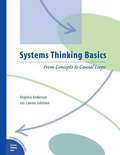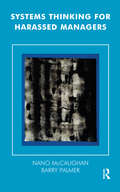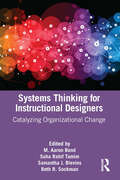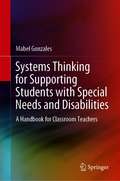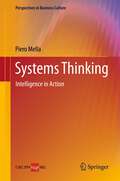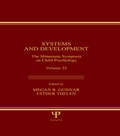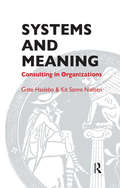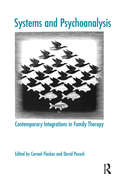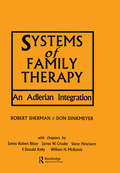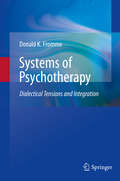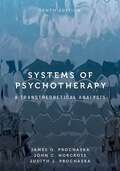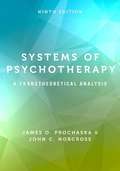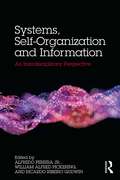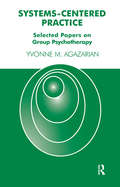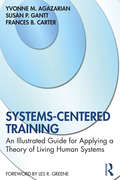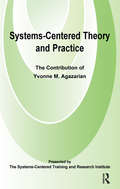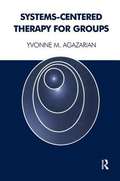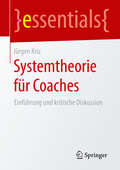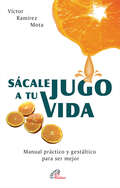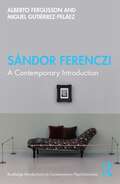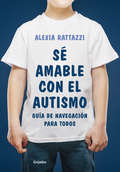- Table View
- List View
Systems Theory in Action
by Shelly Smith-Acuña"Smith-Acuña illuminates the structural hierarchy, roles, and boundaries that give a system structure. The relationship between parts and wholes is both simple and profound, and particularly important in looking at systems structure. These morsels of wisdom are good examples of Smith-Acuña's grace as a systems theory tour guide: one moment she's digging deeper into the nuances among the theories, the next moment she's simplifying without dumbing down, but in a manner that is enormously liberating. We enjoy the fun, full, and informed journey with her." -Frank S. Pittman III, MDA practical presentation of systems theory as a fundamental model for clinical practiceValuable for seasoned mental health professionals as well as those in training, Systems Theory in Action presents systems theory-the unifying principles surrounding the organization and functioning of systems-as it applies to individual, couples, and family therapy.This innovative book explores systems theory as an effective model for general mental health practice. It examines the role systems theory can play, specifically in understanding clients' presenting problems in context, within the various systems and subsystems in which the problems are embedded.Filled with realistic clinical stories illustrating relevant concepts that tie theory to technique, Systems Theory in Action takes an in-depth look at: Systems theory as a solid guide through the dynamic process of psychotherapy The multilayered value of observing human interactions through a systems view Systemic thinking, its core components, and how it serves to reveal a "big picture" view of clients and their presenting problemsSystems Theory in Action is a unique contribution to the field, translating the technical terminology of general systems thinking into common, everyday language.
Systems Thinking Basics: From Concepts to Causal Loops
by Virginia Anderson Lauren Johnson<p>Systems Thinking Basics is a self-study, skill-building resource designed to introduce you to the power of systems thinking tools. With an emphasis on behavior over time graphs and causal loop diagrams, this workbook guides you step by step through: Recognizing systems and understanding the importance of systems thinking; Interpreting and creating behavior over time graphs and causal loop diagrams; Applying and practicing systems thinking day-to-day. <p>Each of the book's six main sections contains a wealth of examples from the business world, as well as learning activities that reinforce concepts and provide you with the opportunity and space to practice. An array of appendices offers: Extra practice activities; A summary of key points and suggested responses to the learning activities; A table showing the "palette" of systems thinking tools available; A glossary of systems thinking terms; A list of additional resources; A summary of the systems archetypes. <p>The many diagrams within the book clarify concepts and visually reinforce key principles. Systems Thinking Basics is ideal for aspiring systems thinkers eager to try their hand at using these powerful tools</p>
Systems Thinking for Harassed Managers (The Systemic Thinking and Practice Series)
by Nano McCaughan Barry PalmerThis book describes the processes that shape organisational life and shows how managers can work together to help one another to work out their problems and develop their skills. The authors draw on their experiences of working with managers and in the group relations field.
Systems Thinking for Instructional Designers: Catalyzing Organizational Change
by M. Aaron BondSystems Thinking for Instructional Designers offers real-world cases that highlight how designers foster continuous improvement and manage change efforts across organizational contexts. Using a systems thinking approach, each case describes a holistic process that examines how a set of interdependent elements can be analyzed and coordinated to influence change. Instructional designers, faculty, program directors, digital learning leaders, and other development specialists will learn how systems thinking can solve authentic, real-world challenges. The book’s rich narratives cover both successes and failures of meaningful growth, paradigm shifts, and large-scale problem-solving in a variety of settings, including education and industry.
Systems Thinking for Supporting Students with Special Needs and Disabilities: A Handbook for Classroom Teachers
by Mabel GonzalesThis book provides school leaders and teachers with research-based theories and models on systems thinking and on inclusive education. It offers the ‘why’, ‘what’ and ‘how’ of inclusive teaching and learning with specific references to a range of special needs. It discusses topics such as a sustainable approach to inclusion, differentiation of learning programs and activities, and a range of assessment approaches to support teaching and learning. The book also presents the social aspects of inclusion and encourages teachers and school leaders to focus not only on the academic aspects of education but the social and emotional growth of the student. It highlights the value of parent input and promotes the forming of parent partnership to enhance student learning and wellbeing. Part One of the book gives practical suggestions on how school leaders can apply systems thinking to mobilise the school and school community to contribute to the ideals of Education For All. Part Two discusses a range of disabilities with each chapter covering the medical definitions and characteristics of the condition, the challenges faced by the student, their parents and teachers, and presents evidence-based strategies and classroom management tips to help teachers with their everyday classroom needs. The book helps to heighten school leaders’ awareness on how to use systems thinking to mobilise the school community to action. It strengthens teachers' confidence and builds their capacity in providing all students with access to flexible learning choices to help them achieve educational goals and develop a sense of belonging.
Systems Thinking: Intelligence in Action
by Piero MellaThe core belief underlying this book is that the most useful and effective models to strengthen our intelligence are system ones, developed following the logic of Systems Thinking. Such models can explore complexity, dynamics, and change, and it is the author's view that intelligence depends on the ability to construct models of this nature. The book is designed to allow the reader not only to acquire simple information on Systems Thinking but above all to gradually learn the logic and techniques that make this way of thinking an instrument for the improvement of intelligence. In order to aid the learning and practice of the Systems Thinking discipline, the author has abandoned a rigid formal language for a more discursive style. He writes in the first person, with an ample number of citations and critical analyses, and without ever giving in to the temptation to use formal mathematics.
Systems and Development: The Minnesota Symposia on Child Psychology, Volume 22 (Minnesota Symposia on Child Psychology Series)
by Megan R. Gunnar Esther ThelenThis volume covers the 22nd Annual Minnesota Symposia on Child Psychology. The theme of the conference was the use of a systematic approach to the study of development. An analysis of systems theory, its applications to the study of development, its benefits, and its drawbacks are considered. The contributors, among the leaders in this field, discuss the application of systems concepts to the analysis of core issues in areas as diverse as motor and social development.
Systems and Meaning: Consulting in Organizations (The Systemic Thinking and Practice Series)
by Gitte Haslebo Kit Sanne NielsenThis book looks at organisational problems occurring in a particular context, and clearly traces the way problems arise out of relations amongst the different parts of the larger system. It also pursues the meanings that these problems have for individuals and organisations alike. The authors, who are both practitioners experienced in working with organisations, show how their ideas can be implemented in different settings.
Systems and Psychoanalysis: Contemporary Integrations in Family Therapy (The Systemic Thinking and Practice Series)
by David Pocock Carmel FlaskasThis book demonstrates how accomplished clinicians can promote the emergence of a richness and creativity that appeals to practitioners of systemic family therapy, not least because of the immediate relevance and usefulness of the ideas. It will be useful to the field of psychotherapy.
Systems of Family Therapy: An Adlerian Integration
by Robert Sherman Don DinkmeyerFirst published in 1987. Routledge is an imprint of Taylor & Francis, an informa company.
Systems of Psychotherapy
by Donald K. FrommePsychotherapy today encompasses a broad spectrum of approaches that focus to a varying extent on psychophysiological, behavioral, environmental, or other aspects of human problems. Despite the overlap that exists between many of these approaches, there is no method that integrates more than a few of these aspects. It is therefore important to understand the inherent advantages and disadvantages of each therapy system, and how each helps people to solve their problems. Systems of Psychotherapy: Dialectical Tensions and Integration provides an in-depth overview of the major therapeutic systems in practice today and outlines the philosophical differences and opportunities for integration among them. This volume also considers the new ideas and approaches to therapy stemming from the postmodernist and integrative movements. By highlighting the unique merits of each system, readers are encouraged to combine factors present in the various systems to create a comprehensive view of human nature and functioning that will improve therapeutic outcomes. Topics covered in this volume include: *Empirical foundations of psychotherapy *Treatment planning and the initial interview *Psychopharmacology *Cognitive-Behavioral interventions *Humanistic approaches *Interpersonal approaches *Family systems and couples approaches *Ecosystemic interventions Systems of Psychotherapy is an educational text which spans historical and contemporary issues in psychotherapy and is an ideal reference for students of clinical, counseling, and school psychology, psychiatric residents, and graduate students in clinical social work.
Systems of Psychotherapy: A Transtheoretical Analysis
by James O. Prochaska John C. Norcross Judith J. ProchaskaComprehensive, systematic, and balanced, Systems of Psychotherapy uses a wealth of clinical cases to help readers understand the major psychotherapies, including psychodynamic, existential, experiential, interpersonal, exposure, behavioral, cognitive, third wave, systemic, multicultural, and integrative. The tenth edition of this landmark text thoroughly analyzes 15 leading systems of psychotherapy and briefly surveys another 32, providing students and practitioners with a broad overview of the discipline. The book explores each system's theory of personality, theory of psychopathology, and resulting therapeutic process and relationship. Through these explorations, the authors clearly demonstrate how psychotherapy systems agree on the processes producing change while diverging on the elements in need of change. Additionally, the authors present the central limitations, outcome research, and future directions of each system of psychotherapy. This tenth edition features a reconfigured chapter on positive psychological treatments, expanded coverage of the Unified Protocol and transdiagnostic personalizing, new self-reflection exercises, additional examples of child and adolescent therapy, and more than 500 new references, recommended readings, and web resources.
Systems of Psychotherapy: A Transtheoretical Analysis
by James O. Prochaska; John C. NorcrossComprehensive, systematic, and balanced, Systems of Psychotherapy uses a wealth of clinical cases to help readers understand a wide variety of psychotherapies - including psychodynamic, existential, experiential, interpersonal, exposure, behavioral, cognitive, third wave, systemic, multicultural, and integrative. The ninth edition of this landmark text thoroughly analyzes 15 leading systems of psychotherapy and briefly surveys another 32, providing students and practitioners with a broad overview of the discipline. <p><p> The book explores each system's theory of personality, theory of psychopathology, and resulting therapeutic process and therapy relationship. Through these explorations the authors clearly demonstrate how psychotherapy systems agree on the processes producing change while diverging on the elements in need of change. Additionally, the authors present cogent criticisms of each approach from cognitive-behavioral, psychoanalytic, humanistic, cultural, and integrative perspectives. This ninth edition features updated meta-analytic reviews of the effectiveness of each system, new sections on Lacanian analysis, mentalization therapy, and psychotherapy with gender nonconforming people, as well as new sections and updates throughout the text.
Systems, Self-Organisation and Information: An Interdisciplinary Perspective
by Pereira Junior Alfredo William A Pickering Ricardo Ribeiro GudwinComplex system studies are a growing area of central importance to a wide range of disciplines, ranging from physics to politics and beyond. Adopting this interdisciplinary approach, Systems, Self-Organisation and Information presents and discusses a range of ground-breaking research in complex systems theory. Building upon foundational concepts, the volume introduces a theory of Self-Organization, providing definitions of concepts including system, structure, organization, functionality, and boundary. Biophysical and cognitive approaches to Self-Organization are also covered, discussing the complex dynamics of living beings and the brain, and self-organized adaptation and learning in computational systems. The convergence of Peircean philosophy with the study of Self-Organization also provides an original pathway of research, which contributes to a dialogue between pragmatism, semeiotics, complexity theory, and self-organizing systems. As one of the few interdisciplinary works on systems theory, relating Self-Organization and Information Theory, Systems, Self-Organisation and Information is an invaluable resource for researchers and postgraduate students interested in complex systems theory from related disciplines including philosophy, physics, and engineering.
Systems-Centered Practice: Selected Papers on Group Psychotherapy
by Yvonne M. AgazarianSystems-Centered Practice presents a series of papers that trace the development of the theory of living human systems between 1987 and 2002. As the theory develops, so do the methods and techniques that put it into practice. The book also describes in detail the connection between the hierarchy of defence modification and the specific phases of system development that determine readiness for change. The papers in this volume contribute to our knowledge of the permeability of the boundaries between clinical and social psychology through the investigation of living human systems, and of systems-centered group and individual therapy. The author's considerable body of work constitutes a blend of creativity and learning of the highest order.
Systems-Centered Therapy for Groups
by Yvonne M. AgazarianSystems-Centered Therapy (SCT) is an innovative approach to psychotherapy that synthesizes a finely-tuned awareness of the defensive roles of anxiety and depression, with an analysis of the phases of group development. This volume introduces the author's theory of living human systems and explicitly maps out its use in a structured treatment model applicable to work with any population. In rich conceptual detail, the volume presents SCT as a powerful modality that enables clients to safely "sit on the edge of the unknown" and transform their ways of relating to themselves and each other. It will be received with interest by all practitioners and trainees in group and individual psychotherapy.
Systems-Centered Therapy: Clinical Practice with Individuals, Families and Groups
by Yvonne M. AgazarianSystems-centered therapy (SCT) brings an innovative approach to clinical practice. Developed by the author, SCT introduces a theory and set of methods that put systems ideas into practice. The collection of articles in this book illustrates the array of clinical applications in which SCT is now used. Each chapter introduces particular applications of SCT theory or methods with specific examples from practice that help the theory and methods come alive for the reader across a variety of clinical contexts. This book will be especially useful for therapists and clinical practitioners interested in sampling SCT, for those who learn best with clinical examples, and for anyone with a serious interest in learning the systems-centered approach.
Systems-Centered Training: An Illustrated Guide for Applying a Theory of Living Human Systems
by Yvonne M. Agazarian Susan P. Gantt Frances B. CarterThis illustrated book shows how "thinking" systems offer new ways of seeing people which can help us see and do things differently. The authors describe how a theory of living human systems was developed and even recently revised. This major revision led to a theory of the person-as-a-system and its role-systems map that helps us see which system in us and in others is running the show. The authors illustrate how life force energy fuels the hierarchy of living human systems and how theory and practice with role-systems can be useful in everyday life. They begin with describing how they have used the new illustrations as a map to locate the contexts of our roles. Using this map has also enabled the authors to identify the role-systems and explore the territory of ourselves and our groups in new ways that deepened our understanding of roles and role locks. This book illustrates systems-centered therapy and training (SCT) theory by offering a practical theory to guide group psychotherapists, leaders and consultants in working with group dynamics.
Systems-Centred Theory and Practice: The Contribution of Yvonne Agazarian
by Yvonne M. AgazarianSystems-centered therapy (SCT) brings an innovative approach to clinical practice. Developed by the author, SCT introduces a theory and set of methods that put systems ideas into practice. The collection of articles in this book illustrates the array of clinical applications in which SCT is now used. Each chapter introduces particular applications of SCT theory or methods with specific examples from practice that help the theory and methods come alive for the reader across a variety of clinical contexts. This book will be especially useful for therapists and clinical practitioners interested in sampling SCT, for those who learn best with clinical examples, and for anyone with a serious interest in learning the systems-centered approach.
Systems: Centered Therapy For Groups
by Yvonne M. AgazarianIn living human systems and explicitly maps out its use in a structured treatment model applicable to work with any population. In rich conceptual detail, the volume presents SCT as a powerful modality that enables clients to safely "sit on the edge of the unknown" and transform their ways of relating to themselves and each other. It will be received with interest by all practitioners and trainees in group and individual psychotherapy.
Systemtheorie für Coaches: Einführung und kritische Diskussion (essentials)
by Jürgen KrizDas essential bietet eine prägnante Übersicht über zentrale Konzepte und Begrifflichkeiten, die häufig im Kontext systemischen Coachings vorkommen. Den Ausführungen liegt ein Ansatz zugrunde, der auf dem Boden interdisziplinärer Systemtheorie (,,Synergetik") als ,,Personzentrierte Systemtheorie" bekannt ist. Die dort entwickelten Konzepte und Prinzipien ermöglichen ein systemtheoretisch begründetes und konsistentes Verständnis bezüglich der Entstehung, Stabilität und Veränderung von Problemstrukturen. Damit lassen sich zentrale Aspekte und Fragen, die im Bereich des Coachings auftreten, auf systemtheoretische Weise betrachten, was es ermöglicht, das Handlungspotenzial im systemischen Coaching in konsistenter Weise weiterzuentwickeln und zu vertiefen.
Sácale jugo a tu vida
by Vîctor Ramîrez Mota"Encontrarás tips para empezar a cambiar tu forma de pensar. Los cambios son buenos cuando se trata de buscar la felicidad, el autor nos propone identificar lasactitudes a cambiar y nos asegura que cambiaremos la manera de sentir y consecuentemente la manera de tratar a los demás."
Sálvate, la vida te espera
by Boris CyrulnikUn lúcido análisis sobre la memoria, la imaginación y los recuerdos a través de una historia real de superación, pero también sobre el trauma, sobre las heridas y la sanación. Boris Cyrulnik, eminente psiquiatra y psicólogo, profundo conocedor de la mente, vivió una infancia traumática. Separado de sus padres, que fueron asesinados en campos de concentración, vivió como un fugitivo, escondido en casas de familias de acogida y en orfanatos. Como la mayoría de los supervivientes al volver de los campos, y como la mayoría de personas que han vivido situaciones traumáticas durante su infancia, Boris Cyrulnik se refugió en el silencio después de la guerra. Sálvate, la vida te espera es un libro sobre el trauma, sobre las heridas y la sanación, sobre la imposibilidad de contar en un mundo en el que nadie quiere escuchar. Sobre la indiferencia que mata y los vínculos que salvan, sobre las ilusiones del recuerdo, sobre ese fenómeno extraño que se llama memoria, que no es la reconstrucción del pasado sino su representación, y que no cuenta la verdad histórica de los hechos sino otra verdad, todavía más real: la de la persona que recuerda. A través del relato de su propia historia, Boris Cyrulnik ayuda a todos aquellos que intentan escapar de un pasado marcado por el dolor. Así empieza Sálvate, la vida te espera: «He nacido dos veces. La primera vez no estaba allí. Mi cuerpo vino al mundo el 26 de julio de 1937 en Burdeos. Me lo han contado, y estoy obligado a creerlo ya que no guardo ningún recuerdo. Mi segundo nacimiento está grabado en mi memoria. Una noche fui arrestado por unos hombres armados que rodeaban mi cama. Venían a buscarme para matarme. Mi historia nace aquella noche.» Reseñas:«Los comentarios sobre el libro de Cyrulnik no aportan nada. Hay que leerlo. Absolutamente. "Mi vida mental se había detenido a los dos años,cuando mi madre, tras el alistamiento de mi padre en el ejército francés, se quedó sola y angustiada por la idea de su inminente detención. Después siguieron unos años de persecución, de trato constante con la muerte y de aislamiento sensorial. Los desgarros afectivos, repetidos una y otra vez, la prohibición de salir o de ir a la escuela, el sentimiento de ser un monstruo hicieron imposible el menor desarrollo. No sufrí durante estas agresiones ya que mi alma estaba paralizada. Uno no siente nada cuando está en 'agonía psíquica', se respira un poco, y ya está." ¿Qué más añadir? ¿Qué más decir?»Valérie Trierweiler, Paris-Match «Boris Cyrulnik abre las puertas de su "cripta", de su caja de Pandora de la que emerge un relato autobiográfico conmovedor... Reconstruye su pasado con sus abismos, sus sufrimientos, sus recuerdos engañosos, sus dudas, sus zonas sombrías... Como un investigador, reconstruye el puzle de su vida. Boris Cyrulnik es un gran resiliente. A través de este libro, se toma a sí mismo como objeto de estudio. Intentando discernir entre lo verdadero y lo falso, acorrala sus recuerdos. Algunos reales, otros enriquecidos, inconscientemente, para dar coherencia a lo impensable, para poder sobrevivir.»Le Monde
Sándor Ferenczi: A Contemporary Introduction (Routledge Introductions to Contemporary Psychoanalysis)
by Miguel Gutiérrez-Peláez Alberto FergussonThis book aims to present an up-to-date introduction and critical study of one of the most important psychoanalysts of all times, Sándor Ferenczi. The book presents Ferenczi as a person; his discovery of psychoanalysis and his relationship with Freud; the theoretical and clinical novelties he introduced to psychoanalysis; his deep political and social commitment, striving for the democratization of psychoanalysis; and the great relevance of his thought and perspective for the future. It also talks about his repression in the history of psychoanalysis as well as his influence in the following generations of psychoanalysts. The reader will be presented with the most relevant historical milestones and concepts, with new insights regarding some of Ferenczi’s most fundamental ideas (such as his trauma theory, his technical innovations or his developments regarding the end of analysis), as well as an informed viewpoint of his legacy, the contemporary readings of his work and the institutions and associations that continue following the path traced by l’enfant terrible of psychoanalysis. This book will be of interest both for the novel reader who has had none or scarce contact with the person and/or work of Sándor Ferenczi, as well as to the psychoanalysts, clinicians and scholars, who have a deeper contact and understanding of the work of the Hungarian analyst.
Sé amable con el autismo: Manual de navegación para todos
by Alexia RattazziLa doctora Alexia Rattazzi, especialista en autismo, propone un camino diferente y posible para abordar una de las condiciones más complejas y difíciles de diagnosticar y de tratar. Uno de cada cincuenta y nueve niñxs tiene alguna condición dentro del espectro autista (CEA). Pero ¿qué es el autismo? ¿Cómo se diagnostica? ¿Se puede prevenir? ¿Qué rol tiene la Salud Pública? La doctora Alexia Rattazzi aborda cada una de estas preguntas (y muchas más) para explicarnos porqué el autismo no es una enfermedad, sino una condición. Cuándo es necesario brindar apoyo y cuál es la forma de contención que las personas más cercanas pueden proporcionar. Sé amable con el autismo no solo ofrece definiciones y abordajes, también demuestra la importancia de la calidad humana cuando se trata de acompañar a personas con CEA y propone herramientas para navegar en las aguas de la diversidad. Los valores, las creencias y los mitos forman parte de la sociedad que habitamos y, en este sentido, las personas pueden ser un instrumento transformador de la realidad de otros. Actos tan sencillos como sonreír, ser pacientes y creer en el potencial del otro pueden cambiar el presente y el futuro de cualquier persona, tenga o no una discapacidad. Este libro es una invitación a cambiar la mirada sobre el autismo y un estímulo para transformar el mundo en un lugar más inclusivo para todxs.

